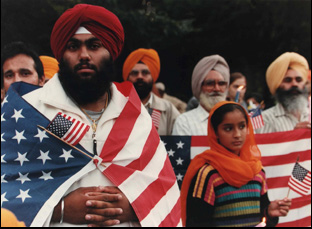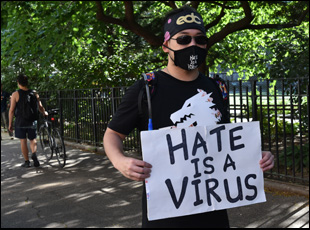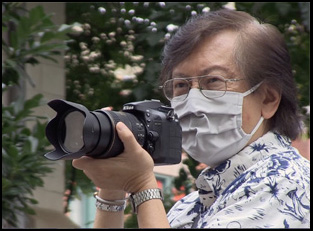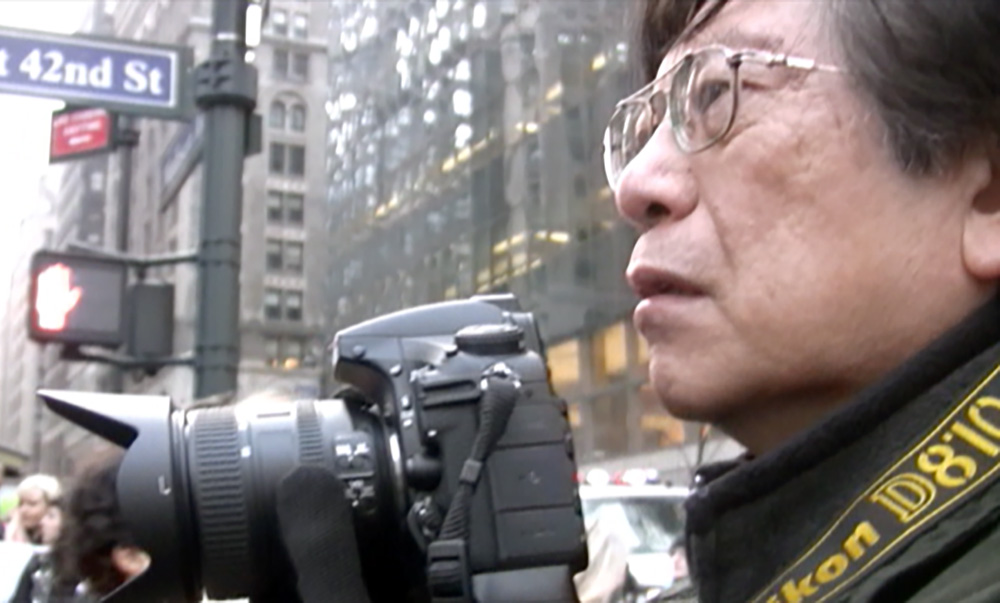Jennifer Takaki was just looking for a restroom when life took her in an entirely different direction. In 2003, she had recently moved to New York from Colorado where she worked for a local TV news station to New York and was attending an Asian American Journalist Association event where a friend was speaking when being unfamiliar with the building, she asked the nearest person where the facilities were. Depending on how you look at it, it was either the best or worst thing that could’ve happened to her when it was the legendary photographer Corky Lee, who wanted to give her the whole history of the building in trying to explain where its bathrooms were as nature called.
“I think that says a lot about Corky, right?” Takaki says of the memorable introduction to one of the biggest bastions of institutional knowledge in New York’s Chinatown, ultimately mirroring her experience of intending to make a short about him after and spending the next two decades following Lee for the feature “Photographic Justice: The Corky Lee Story.” “You could spend five minutes with a guy and realize, ‘I didn’t intend to do a documentary, but you knew that he was something special and something that needed to be documented.”
Lee passed away in 2021 after a brief bout with COVID, drawn out as he always had been to cover the Asian American community as they experienced a wave of hatred when the virus was connected to China, and just as he was always around to capture pivotal moments in his native New York and beyond from 1971 on when he started taking photographs professionally, Takaki is there to observe what become the last 20 years of a remarkable career, documenting a culture woefully underreported on by the mainstream press. When Lee’s inspiration to become a photographer was from the famous picture of the Golden Spike at Promontory Point, Utah where predominantly Chinese American labor was employed to connect the Union Pacfiic railroad tracks from the west to the Central Pacific Railroad from the east yet were suspiciously missing from a commemorative portrait, he made sure that they would be part of the historical narrative going forward.
Not only would Lee return to Promontory Point on an annual basis in the present to reassert the place of Asian Americans in the construction of the transcontinental railroad with other Asian American activists in the frame, but ultimately take close to 800,000 pictures of events happening in real time, from protests against the Vietnam War during the ‘70s and the outrage sparked by the racially motivated murder of Vincent Chin in 1982 to scenes of celebration and daily life across various Asian diasporas to convey the totality of their experience in America. Yet as many memorable subjects as Lee trains his camera on over the years, you’d be hard-pressed to find any more lively and engaging than the photographer himself, who kept mostly quiet about his personal life, but could be as brash and outspoken as you might expect from someone raised in Queens.
That attitude comes across in both words and pictures as personal interviews are accompanied by Lee’s extraordinary work, which clearly continue to tell a story after the photographer’s passing, and on the eve of the release of “Photographic Justice” in theaters, which coincides with the publication of a compendium of Lee’s work “Cory Lee’s Asian America,” Takaki spoke about helping to carry on his legacy, the critical importance of underrepresented communities to document their lives and being able to consider an entire cultural history through the lens of Lee’s personal experience.

I wanted to [make films] about people who have a singular vision, just doing what they do through thick and thin because a lot of people question why they do what you do, and I just happened to run into Corky randomly and that’s how it started. Then I would just say, “Corky, what do you have up on this week?” And Corky would have a list — I don’t know how he did it, but he would like type everything — [where] “on Tuesday, I’ve got this and this and this and this,” so we just kind of kept going from there. And every time I would see him, I would just say, “What’s on the agenda?” And it was like week to week.
I also happened to be at a point when his wife had just died, and I feel like that’s when the accolades started to come [to acknowledge his career], which he attributed partly to her. So I came at it in a good point, but he was still very much under the radar, and in fact, I would say he’s still a little under the radar after everything, so we still have work to be done.
One of my favorite sequences in the film is actually early in the film when you see him catalog all the cultural events he covers during a calendar year. What was it like showing how busy he was?
Well, Corky did that every year, so I always knew that that was like a really important part of it and I think Corky just magically was everywhere, so as a documentarian, it was a very fortunate situation. I was very privileged to kind of be a part of his process and to see the photos that he took, but really telling that story of the AAPI history through his photos over a year’s time was important and it comes across over like the breadth of cultures that he covered.

I attribute all of that to our editor Linda Hattendorf, who really has the heart and soul of an activist and she really honored Corky’s story. She understood I had all these like little topics that I wanted to make sure we hit, but it was a struggle for us to figure that out. We did it through just a lot of reorganizing and then a lot of feedback sessions with different people, people who knew Corky, people who didn’t, just the regular rigmarole until we got it right. And it was really difficult and changed as Corky’s situation changed. Some of the history got thrown out the window because we really wanted to focus more on Corky and his story.
The fact that there were rhythms to his routine – not only covering certain events every year, but as I understand the picture at Promontory Point was actually something he did annually – did that make it easier to be where you needed to be?
He actually did the railroad in 2002 for the first time, and it was before I started filming him. It was part of an article in the New York Times, but then he always wanted to recreate it because he wasn’t happy with that photo. He always felt like it was missing something, so he was always trying to recreate it in his head and that didn’t happen [in person again] until 2014, but he brought together all these forces to make it happen, and then subsequently, he wanted to keep doing it into the 150th anniversary, which was in 2019. That scene was actually going to be the last scene [of the movie] and the idea would be that the railroad scene would play and then the film would end and Corky would do the Q&A to match, [with his] grandeur and spread his amazing Corkiness and the film stayed true to everything until he died and then it became a tribute film as opposed to just a bio of him.
Beyond his own work being showcased in the film, much of the archival material wasn’t professionally produced, but the result of activists capturing their own history for posterity. What was it like discovering how important that ended up being as you put this together?
Yeah, that’s a huge part for me. It’s so important because we’re so used to seeing images that we take them for granted, but those images that [activists] took of the Vietnam War with all the Asian-Americans, you wouldn’t find those in the traditional archives. You don’t go to ABC, NBC archives — I tried, and I didn’t know that they wouldn’t be there. They’re actually in the archives of people’s homes, so it was really knocking on doors. DCTV also had provided some incredible archives, but that’s a really important message that communities need to document their own stories so that future generations have access and that they could tell those stories later.

You were coming into this with a news background. Was making a documentary any different?
You don’t really know until you’re [doing it], but it’s about the grants. You have to put everything together for the grants and get the grant money. That’s always the process. Then you have to have your distribution figured out and it is a lot to figure out, but it’s definitely been a privilege from beginning to end. It is why they always say that you need to have someone experienced on the film with you, because when Corky died, I was lost, but Linda [Hattendorf, the editor] helped me. We had to put together a press release and everything because people were starting to call and it was overwhelming because I’m still dealing with his death.
I’m guessing the film has allowed people to grieve as you’ve started to get it out into the world.
When it first came out at DOC NYC, there were a lot of people in the community who went to see it and just bawled, and I was just at ASU [recently], and some of the students came up and they said they didn’t even know Corky and they weren’t even Asian started crying. I think everyone really feels for Corky because he’s such a compelling character and he really showed such passion for a community that he cared about and you buy into him as a person and just want to care about the things that he cared about, so when you see the community grieve in the film, that’s a very difficult thing to see. They’re grieving for their loss.
The film already seems to have a multiplier effect and I don’t know how coordinated it is, but the release is tied to the publication of the book “Corky Lee’s Asian America” and there’s a new exhibit of his work in New York. Has that been exciting to see?
It’s been so exciting to see the legacy out there. We had the Google Doodle in May of last year that came out and then there’s the Corky Lee Way [the corner of Mott and Mosco in New York’s Chinatown, renamed for the photojournalist]. And then of course there’s the book and our theatrical [run] and then there’s the PBS and there’s so many other great stories about Corky that people have written or done other movies [about], so it’s heartening. I think that there cannot be enough about Corky Lee out there.
“Photographic Justice: The Corky Lee Story” opens on April 19th in New York at DCTV Firehouse Cinema and April 26th in Los Angeles at the Laemmle Glendale.




